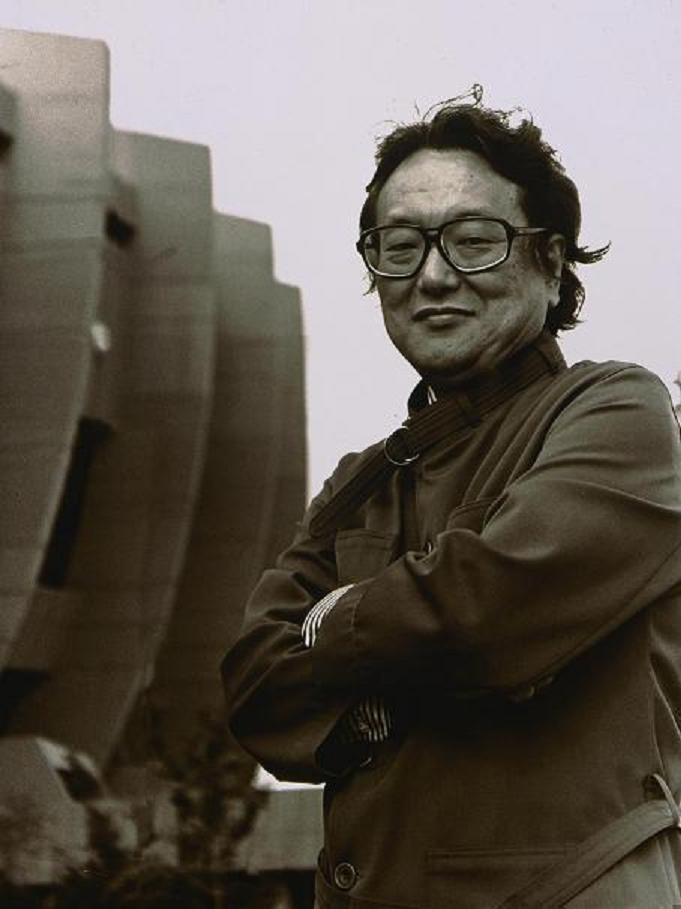- Kim Swoo Geun
Infobox Korean name

imgwidth=200px
caption=Kim Swoo Geun in front of Seoul Olympic Stadium inSongpa-gu ,Seoul ,South Korea .
hangul=김수근
hanja=linktext|金|壽|根
rr=Gim Sugeun
mr=Kim SukŭnKim Swoo Geun (
February 20 1931 –June 14 1986 ) was a prominentSouth Korea narchitect ,cite web|title=Culture and the City in East Asia |url=http://books.google.com/books?id=dzoMKxeFWqMC&pg=PA118&dq=Kim+Swoo+Geun+Architect&lr=&num=20&ei=y8wXSNihNYPUzASao8mFCA&sig=CdLMbv9dYa2Sz3w_fHyVTNGSdwI |publisher=Oxford University Press |language=English |date=1997 |isbn=0198233582 |accessdate=2008-04-30 |author=Won Bae Kim |coauthors=Mike Douglass, Sang-Chuel Choe|pages=118 ~ 123] educator, publisher and patron of artists. Along with architect Kim Joong Up (김중업), he is recognised as a significant contributor in the history of Korean architecture.cite web|title=SPACE Group |url=http://www.space-arch.com/eng/tour/story/list.html |publisher=SPACE Group Official site |language=English|accessdate=2008-04-30] With his support for diverse art genres ofKorean culture , he was referred to asLorenzo de Medici ofSeoul by "TIME" in 1977.cite news|url=http://www.segye.com/Articles/News/Culture/Article.asp?aid=20060605000760&ctg1=07&ctg2=00&subctg1=07&subctg2=00&cid=0101050700000&dataid=200606051432000110 |title=His architecture is his philosophy (그의 건축은 철학이다…타계 20주기 '지금 여기 김수근' 전)|publisher=Segye Ilbo |author=Pyon, Wan-sik (편완식)|date=2006-06-05|accessdate=2008-05-01|language=Korean|]Biography
Kim Swoo Geun was born the first son of Kim Yong-hwan (김용환) and Kim Usudal (김우수달) in Sinap-dong (신압동),
Chongjin ,North Hamgyong province. While Kim was in second year atKyunggi Public Middle School (경기공립중학교), he began to take an interest in architecture, introduced by his English tutor and a US soldier.cite news|url=http://www.mediatoday.co.kr/news/articleView.html?idxno=33820 |title=Did the Kyunghyang Shinmu building have a hotel? (경향신문에 문화관광호텔이 있었다?)|publisher=Media Today |author=Jeong, Eun-gyeong (정은경)|date=2005-01-14|accessdate=2008-05-01|language=Korean|]After his graduation from the school in 1950 and Kim entered
Seoul National University , majoring in architecture. In 1952, during theKorean War , he withdrew from the school and went abroad toJapan where he studied modern architecture atTokyo National University of Fine Arts and Music . During his study at this school, he interned at Hirada Matsuda (松田平田)'s architectural firm.cite web|url=http://100.empas.com/dicsearch/pentry.html?s=K&i=234702&v=46 |title=김수근 (金壽根) |publisher=Empas /EncyKorea |accessdate=2008-05-01|language=Korean|] In 1960 he received amaster's degree in architecture fromTokyo University where he finished his doctoral course as well.In 1959, he won the competition for the
National Assembly Building of South Korea, but his proposal was not realized due to the political situation at that time. In 1960, he returned to his country with his Japanese wife Michiko Yajima (矢島道子). He would eventually father three children with her. In 1961 he founded his architectural firm, "Kim Swoo Geun Planning and Design" (김수근 건축사무소), the predecessor of the current SPACE group. At the same time, he also began to teach at the architecture department ofHong-ik University .Kim designed over 200 projects inside and outside of South Korea during his lifetime. His representative works include "SPACE Group building" (공간 사옥, 1978), "Masan Yangdeok Catholic Church" (마산양덕성당 1979), "
Jinju National Museum " (진주국립박물관 1986) and "Olympic Main Stadium" (올림픽 경기장 1987), which feature his characteristic view of architecture as well as Korean traditional elements.Kim commenced publishing the monthly "SPACE" (월간 공간) in 1966, the first general art journal of South Korea which contributes to recording and distributing
Korean culture . Kim also established SPACE Love (공간사랑) in 1979, a small theater inside of the Space group building and built the SPACE Gallery in 1972, all of which has played an important role for numerous South Korean cultural campaigns. With his contributions crossing over into many diverse genres, Kim is regarded a seminal cultural activist, trying to integrate architecture and other genres of artistic expression.After Kim Swoo Geun died in 1986, a victim of liver cancer at the age of 55, the Kim Swoo Geun Foundation (김수근문화재단) was established in his memory.cite web |url=http://www.encyber.com/search_w/ctdetail.php?masterno=31316&contentno=31316 |title=김수근 (金壽根 1931.2.20 ~ 1986.6.14)|publisher=Doosan Encyclopedia |accessdate=2008-04-30|language=Korean|]
Recognition
According to Park Gil-ryong, a professor of
Kukmin University , Kim was the first in South Korea to proclaim that architecture has to have its own concept and philosophy. The architect Min Hyeon-sik said Kim Swoo Geun lived with the consciousness of how to effectively convey and adapt Korean tradition into contemporary architecture. It was his grand obsession. His achievement as an educator was in mentoring Kim Won, Ryu Chun-su, Min Hyun-sik, Lee Jong-ho, Seung Hyo-sang into being prominent architects, regarded as significant as well.cite web|url=http://www.donga.com/fbin/output?n=200606030029 |title=(건축가 故김수근 20주기 ‘지금 여기’展) |publisher=Dong-a Ilbo | |date=2006-06-03 | accessdate=2008-04-23 |author=고미석 기자 mskoh119@donga.com |language=Korean |]elective works
* 1963 Freedom Center (자유센터) in
Jangchung-dong ,Jung-gu ,Seoul
* 1967Buyeo National Museum inBuyeo ,South Chungcheong Province
* 1969 Tower Hotel (타워호텔) inJangchung-dong ,Jung-gu ,Seoul
* 1970 Korea Exhibition Pavilion atExpo '70 (오사카 엑스포 한국관) inOsaka ,Japan
* 1971 SPACE Group Building (공간 사옥) inWonseo-dong ,Jongno-gu ,Seoul
* 1977Seoul Olympic Stadium , inJamsil ,Songpa-gu ,Seoul
* 1979Cheongju National Museum , inCheongju ,North Chungcheong Province
* 1979 Munye Center and Fine Arts Center (종합문예회관, currently Arko Arts Museum) inMarronnier Park ,Jongno-gu
* 1979 Yangdeok Catholic Church (마산양덕성당) inMasan ,South Gyeongsang Province
* 1980 Kyungdong Presbyterian Church (경동교회) inJangchung-dong ,Jung-gu ,Seoul
* 1983 Embassy building of the United States in Seoul onSejongno inJongno-gu ,Seoul
* 1984National Science Museum, South Korea inYuseong-gu ,Daejeon
* 1985 Bulgwang-dong Catholic Church (불광동성당) inBulgwang-dong ,Eunpyeong-gu ,Seoul Honors
* 1970 Civil Merit Medal, South Korea (국민포장 國民褒章)
* 1971 Pan Pacific Citation from theAmerican Institute of Architects (AIA)cite web|url=http://www.kia.or.kr/kia_image/html/01_02_01_03_01.htm |title=3-1 韓國性의 모색 / 國際建築에서의 位相|publisher=Korean Institute of Architects|language=Korean|accessdate=2008-04-30]
* 1979 Commendatore dell’ Ordine della Stella della Solidariet’ Italiana
* 1982 Honorary Fellow from the American Institute of Architects (AIA) [cite web |url=http://www.aia.org/SiteObjects/files/conted_TH09.pdf |pages=p.9|format=pdf |title=Convention 2007 |publisher=American Institute of Architects |accessdate=2008-04-30|language=English|]
* 1984 Iron Tower, Order of Industrial Service Merit, South Korea (철탑산업훈장 鐵塔産業勳章)
* 1986 Silver Tower, Order of Industrial Service Merit, South Korea (은탑산업훈장 銀塔産業勳章)ee also
*
Architecture of South Korea
*List of tallest buildings in Seoul
*National Assembly Building References
*cite book|title=Architect Kim Swoo Geun, Design Space (건축가 김수근, 공간을 디자인하다) |date=2007 |publisher=나무숲 |language=Korean |accessdate=2008-04-30 |author=Hwang Dujin (황두진) |isbn=8989004276
*cite web|title=Exhibition sheds light on Korea's landmark architect |url=http://www.korea.net/News/News/NewsView.asp?serial_no=20060618020&part=106&SearchDay= |publisher=The Korean Overseas Culture and Information Service (KOIS) |language=Korean |accessdate=2008-04-30 |author= |
*cite journal|url=http://www.dbpia.co.kr/view/ar_view.asp?arid=359641 |title=김수근 건축의 조형성에 관한 연구 - 형태적인 완결성과 군집성 (A Study on the figurative characteristics of Kim, Swoo-Geun's Architecture) |date=2007 |publisher=Korean Architecture Association (대한건축학회)|language=Korean |accessdate=2008-04-30 |author=Jeong Inha (정인하) |pages=p.111~120 |External links
* [http://www.vmspace.com/eng/ Monthly magazine "SPACE"]
* [http://www.spacea.com/eng/main.asp Space Group] (formerly Kim Su-keun's architectural firm)
Wikimedia Foundation. 2010.
